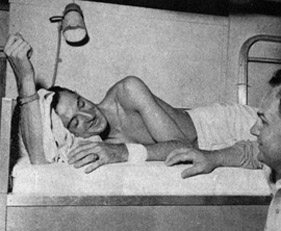|
U.S. Naval Aviation In the South Pacific during WW II Featuring the Lexington Aircraft Carrier The Battle of the Marianas — June 1944 Chapter 2 Page 4 of 5 Pages |
||||||||||||||
| The night was long. I felt a fish once when I moved my hand into it. Not a huge one but big enough to scare me. Salt water will make you sick and eventually I got sick, several times. My hands began to shrivel - my tongue began to swell - I lost a lot of weight that night. During the night I thought of what a predicament I was in: 300 miles from the carrier, 600 miles west of Guam and swimming in 35,000 feet deep water. I needed a miracle. I began to realize that I would not leave a legacy to this world. I had not accomplished much in life - 22 years old - no family of my own and none in sight I had nothing to leave as a legacy. |
||||||||||||||
|
bomber called the “Avenger.” Photo ctsy Life Inc. |
“Dauntless” dive bomber. Photo ctsy Life Inc. |
“Hellcat?” carrier fighter. Photo ctsy Life Inc. |
||||||||||||
 |
||||||||||||||
 |
 |
|||||||||||||
| The next day my squadron came over me about 10:00 a.m. I pulled a dye marker to color the water around me and they dropped me and each of my two crewman a lifeboat. I crawled into my boat, covered up with a sail included in the boat, and went to sleep. About 4:00 p.m., a U.S. fighter plane buzzed the boat and woke me up, and a sea plane landed and picked me up. This was my own squadron coming back to find us. I saw my crewmen in another sea plane and that was the first glimpse I had of them and now I really knew that they were alive. We had been in the water about 22 hours.
Admiral Mitscher wanted to get my eyewitness report so they sent a destroyer over to take me back to my carrier. He immediately called me to report. When I told him what I had seen he thanked me and said, "I believe we sank 2 carriers." And I thanked him for caring enough about downed aviators to send rescue planes over 300 miles to get 5 people out of the water. Two crewmen from another torpedo plane and me and my crew were rescued. That night we lost about 42 men. |
||||||||||||||
 |
||||||||||||||
|
Photo ctsy. “Carrier War,” Oliver Jensen |
||||||||||||||
 |
||||||||||||||
|
Photo ctsy. “Carrier War,” Oliver Jensen |
||||||||||||||
| There were approximately 80 people in the water. It was about 9:00 p.m. and they had to get aboard their carrier. They had been in the air about 5 hours. Admiral Mitscher had turned the search lights on in enemy territory to help planes get back to the carrier, it was so far and they were out of gas. |
||||||||||||||
.jpg) |
||||||||||||||
.jpg) |
||||||||||||||
|
a portion of the Japanese pauses in flight to writhe and twist under American attack. The carrier at above right is taking many hits. |
||||||||||||||
|
|
||||||||||||||
| God surely had allowed him make great decisions in that first battle of the Philippine Sea and it was a great success. That was the last fight the Japanese carriers had. Their squadrons were devastated and for the rest of the war, Japan used mostly the kamikaze pilots. The Lexington was hit by a kamikaze plane after Air Group 16 left for home. We arrived home in late July, 1944. Wanda was in a group of welcoming friends when I got back to Fort Smith in August, 1944 and we married in November, 1944. This November 23rd will be our 56th anniversary. God is so good to us. It took a miracle to bring me back home and allow us to have a wonderful family. God does answer prayer. I now have a legacy. |
||||||||||||||
 |
||||||||||||||
|
Photo ctsy. Warren McLellan |
||||||||||||||
|
Chapter 2— End of Page 4 of 5 Pages — Go to Page 5 Or This Story’s Cover Page — Editor’s Introduction — Table of Contents Fred Gwynn’s “Torpedo 16” — Chapter — 1 — 2 — 3 — 4 Or Home - Contact Us - Cold War Hist. - 91st SRS Hist. - Stardust 40 Mission Story |
||||||||||||||